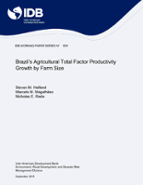Brazil's Agricultural Total Factor Productivity Growth by Farm Size
Date
Sep 2015
The role of farm size has recently come to the forefront of agricultural development debates. Agricultural development policy often focuses on small farms given evidence of their role in poverty reduction and of higher yields. Yet policy has also focused on large farms due to their share of output, efficiency gains from vertical and horizontal integration, and potential employment generation. Brazil offers an interesting case study because of its wide spectrum of farm sizes and the country's dual agricultural policy focus towards large commercial agribusiness enterprises, led by the Ministry of Agriculture, and family farms, led by the Ministry of Agrarian Development. Our purpose is to examine the role that farm size may have in Brazil's agricultural total factor productivity (TFP) growth, which has accelerated at one of the world's fastest rates over the last twenty years. The data are drawn from the agricultural censuses of 1985, 1995-96, and 2006, aggregated at the municipality level into five farm-size classes. The findings of this study point to heavy technical efficiency losses across all size classes, creating a substantial drag on national agricultural TFP growth. Moreover, because farms in the middle of the size distribution achieved the slowest technical change and TFP growth bookended by faster growth in the smallest and largest farm-size classes we identify an unexpected and unexplored source of inefficiency, namely medium-sized farms.




